| View previous topic :: View next topic |
| Author |
Message |
marco campos-venuti

Joined: 09 Apr 2014
Posts: 227
Location: Sevilla



|
 Posted: Dec 19, 2016 08:16 Post subject: Faden Quartz Crystals - (26) Posted: Dec 19, 2016 08:16 Post subject: Faden Quartz Crystals - (26) |
|
|
After the huge output of nice quality fadens from Pakistan and Afghanistan (Kuar Valley in Afghanistan and Dara Ismael Khan District, S. Waziristan, Pakistan), I had the opportunity to look closely at thousands of specimens. The more specimens I looked at, the less I'm convinced that they form in moving fractures by repeated cracking of the crystal. Does someone have an alternative explanation of the phenomenon?
This is the official explanation. Mindat says: "Faden quartz: Crystals and crystal aggregates with a white thread running through the crystals. The thread is caused by repetitive cracking of the crystal during growth and consists of fluid inclusions. Quartz crystals inside the host rock will rupture when the fissure opens. In a silica rich solution, this rupture will heal quickly, forming a crystal that is attached to the opposing rock walls and bridges the new opening. While the fissure continues to open steadily, the crystal will also continue to crack and heal. Because growth is much quicker on fractured surfaces than on regular faces and because it leads to small regular faces on the opposite conchoidal fracture surfaces that do not perfectly match, some of the growth solution is included in the crystal. The repeated rupturing and healing leaves a scar of liquid and gas inclusions in the crystal: a white thread, the "faden". In rare cases, the faden is covered by chlorite, which demonstrates beautifully that a now platy specimen did indeed start as a thin thread."
I tried to make a diagram of the different cases. The "thread" is a cloudy elongated area that represents the direction of growth of the crystal or crystals. Crystals can be fused into one distorted crystal or many crystals can be juxtaposed one beside the other along the same "thread" line. As in the diagram, we can have different situations depending on the orientation of the "thread" inside the crystal. Thread line can be near horizontal, perpendicular to the C axis or more inclined almost near parallel to the C axis. In the first case the quartz crystal will be flat shaped, in the second case the crystal will be distorted as is showed in the diagram.
Some crystals have such a strange shape that it is quite difficult to recognize them as quartz. The best way to orientate the crystal is to recognize the six-sided prism that has a typical horizontal striation.
It is very common that many crystals are juxtaposed along the same thread line. In this case the crystals are often slightly turned in respect to the previous one. This behavior is similar to Gwindels, but Gwindels do not have the white thread inside.
In the official theory, a precursor faden crystal has to touch both sides of a rock fracture, making a bridge. As the fracture moves, the crystal is broken and the bridge is sealed by new quartz molecules.
Why is there no symmetry in the crystals as in most fracture related phenomena?
How can they grow so perfect clear crystals showing a mono-crystal distorted shape as in the diagram?
How can they look terminated?
How is the torsion of multiple crystal fadens explained?
| Mineral: | Faden Quarz Crystal Diagram |
| Description: |
|
| Viewed: |
62209 Time(s) |
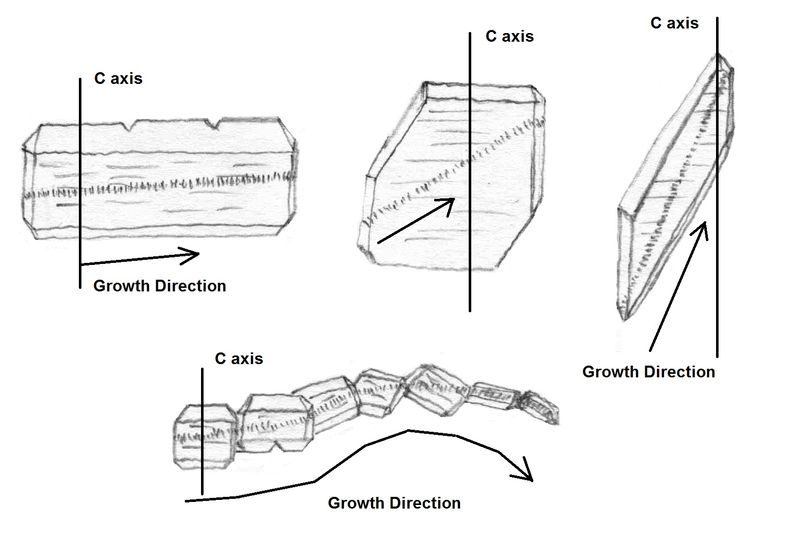
|
| Mineral: | Quartz (variety faden) |
| Locality: | | Dara Ismael Khan District, South Waziristan, Khyber Pakhtunkhwa Province, Pakistan |  |
|
| Dimensions: | 5.5 cm |
| Description: |
| Faden Quartz mono-Crystal |
|
| Viewed: |
62206 Time(s) |
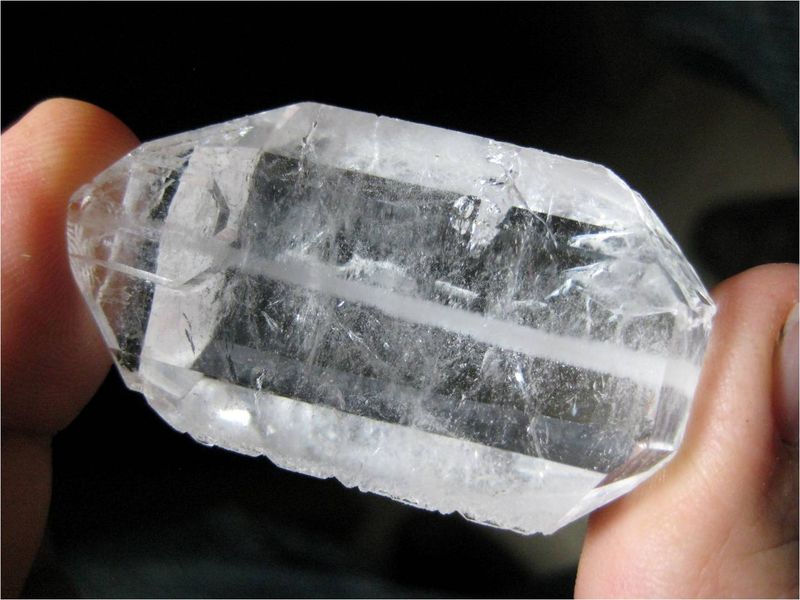
|
| Mineral: | Quartz (variety faden) |
| Locality: | | Dara Ismael Khan District, South Waziristan, Khyber Pakhtunkhwa Province, Pakistan |  |
|
| Dimensions: | 8.8 cm |
| Description: |
| Faden Quartz mono-Crystal |
|
| Viewed: |
62183 Time(s) |
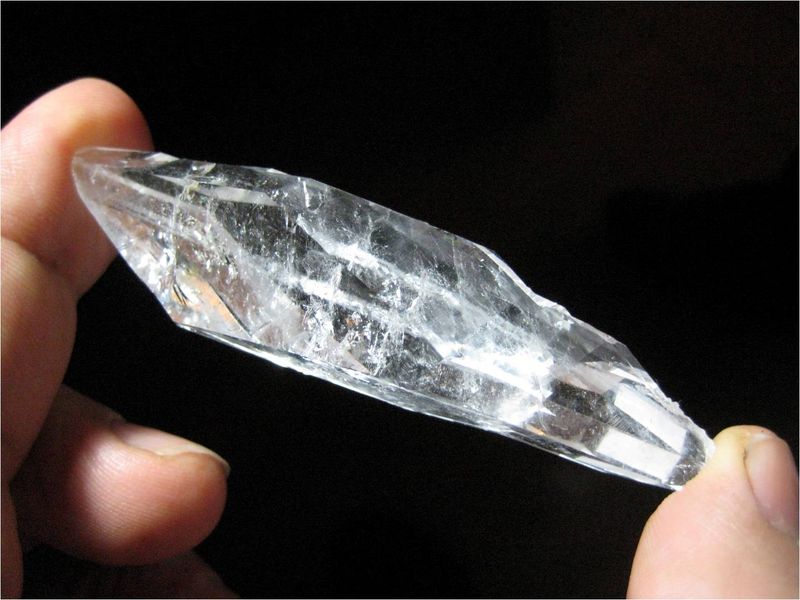
|
| Mineral: | Quartz (variety faden) |
| Locality: | | Dara Ismael Khan District, South Waziristan, Khyber Pakhtunkhwa Province, Pakistan |  |
|
| Dimensions: | 11.5 cm |
| Description: |
| Faden Quartz mono-Crystal |
|
| Viewed: |
62130 Time(s) |
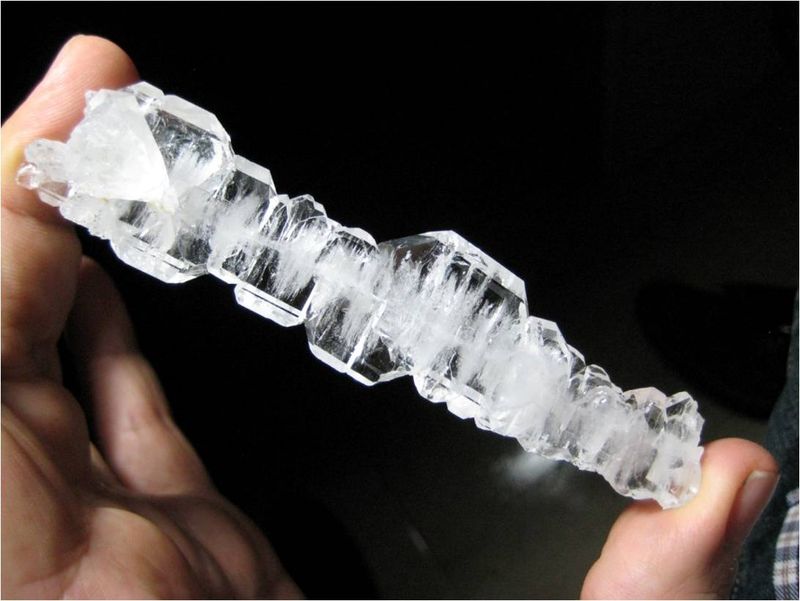
|
| Mineral: | Quartz (variety faden) with Chlorite inclusions |
| Locality: | | Freney d'Oisans, Le Bourg d'Oisans, Grenoble, Isère, Auvergne-Rhône-Alpes, France |  |
|
| Dimensions: | 3.1 cm |
| Description: |
| Faden Quartz Crystal with chloritic heart |
|
| Viewed: |
62143 Time(s) |
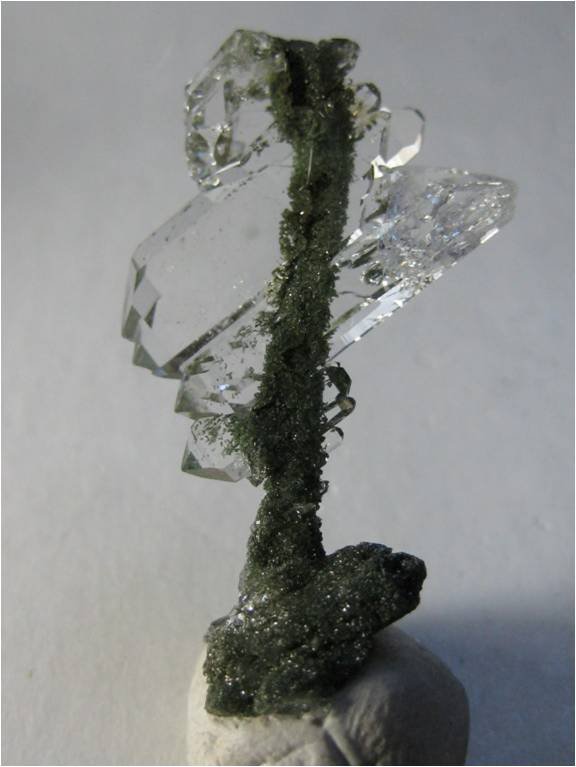
|
| Mineral: | Quartz (variety faden) |
| Description: |
Faden Quartz terminated mono-crystals
Kuar Valley in Afghanistan
4-6 cm |
|
| Viewed: |
62169 Time(s) |
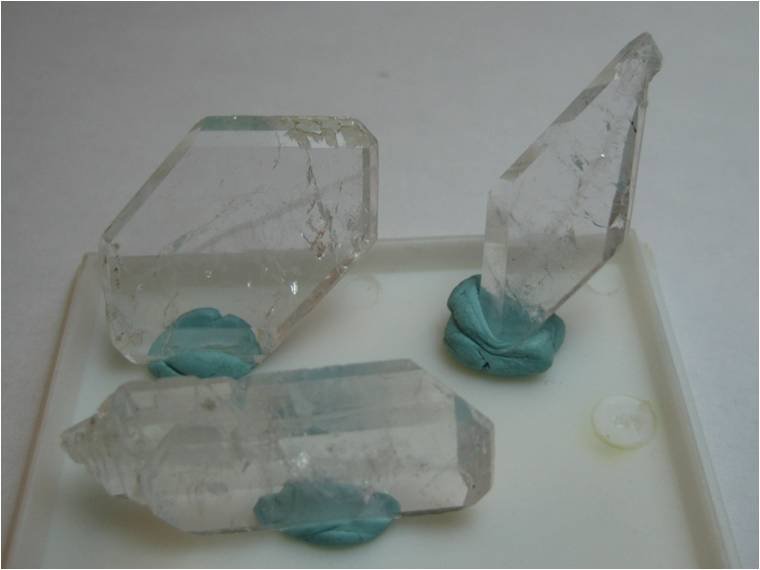
|
|
|
| Back to top |
|
 |
Pete Richards
Site Admin
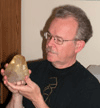
Joined: 29 Dec 2008
Posts: 843
Location: Northeast Ohio



|
 Posted: Dec 19, 2016 10:10 Post subject: Re: Faden Quartz Crystals - (26) Posted: Dec 19, 2016 10:10 Post subject: Re: Faden Quartz Crystals - (26) |
|
|
Having written a fairly important paper on faden quartz years ago in Mineralogical Record, I am probably biased, but let me make a few comments anyway.
1. I have collected examples of alpine veins with multiple quartz needles oriented perpendicular to the vein walls, in some cases spanning the vein and in others failing to do so - but with a matching needle on the other side. These have minimal overgrowths. I think they demonstrate the process "frozen" in place, and show that the explanation is valid, at least sometimes.
2. I have seen some quartz with white thread-like structures inside that I do not believe were faden. The environment is wrong, and the threads lack the characteristic banded fluid inclusion microstructure of typical faden. I think these threads were chalcedony of some sort that got overgrown, but I am not certain of that. This shows that not all quartz with white lines is typical faden quartz.
3. The frequency of smooth overgrowths (e.g. Marco's first photo) vs. multi-crystal ones (his third photo) seems to vary from locality to locality. I suspect it has to do with details of nucleation of the overgrowth and perhaps with slight misfits within certain faden themselves, and provides interest but not much deep meaning.
4. In my experience, curved faden are uncommon, and when the do occur, the curve is always a gentle arc. I have never seen a curved faden as complicated as Marco's bottom drawing, and if it is based on a real specimen, that would be an exceptional specimen! To be clear, I am not saying that such crystals do not exist, only that they are very unusual and I have not seen them.
5. Though the classic model separates the period of faden development from the period of overgrowth with clear quartz, this separation may not be an absolute one. I think Marco's third photo shows a crystal with many fractures part-way through the development of the clear overgrowth, as shown by many wider healed cracks more or less perpendicular to the central faden.
I suppose the extreme of this would be frequent cracking throughout the growth history. This would probably lead to a very weak crystal with a low probability of surviving long enough to be found intact.
6. One might expect that the frequency of differently oriented fadens could be related to the difference in growth rates in different directions in quartz. Faden oriented such that the direction of growth needed to close the gap was a slow one would have a lower probability of surviving the faden formation process than those with a faster growth direction. On the other hand, this might be a subtle distinction compared to the actual process, which might be slow enough that breaks in any direction have time to heal, or fast enough that breaks in any direction do NOT have time to heal (in which case there is no faden). I don't know of any evidence that bears on this possibility.
7. Faden crystals of many other minerals are known, especially from alpine environments. These include adularia, epidote and relatives, dravite, grossular, probably hematite (hard to evaluate!), and probably a number of others that don't come immediately to mind.
_________________
Collecting and studying crystals with interesting habits, twinning, and epitaxy |
|
| Back to top |
|
 |
Pierre Joubert
Joined: 09 Mar 2012
Posts: 1605
Location: Western Cape



|
 Posted: Dec 19, 2016 12:11 Post subject: Re: Faden Quartz Crystals - (26) Posted: Dec 19, 2016 12:11 Post subject: Re: Faden Quartz Crystals - (26) |
|
|
What a fantastic thread Marco!
_________________
Pierre Joubert
'The tree of silence bears the fruit of peace. ' |
|
| Back to top |
|
 |
markbeckett
Joined: 06 Oct 2016
Posts: 41
Location: Cornwall



|
 Posted: Dec 19, 2016 13:17 Post subject: Re: Faden Quartz Crystals - (26) Posted: Dec 19, 2016 13:17 Post subject: Re: Faden Quartz Crystals - (26) |
|
|
| Pierre Joubert wrote: | | What a fantastic thread Marco! |
me too, thanks everyone for an amazing conversation! Merry Christmas!
|
|
| Back to top |
|
 |
alfredo
Site Admin

Joined: 30 Jan 2008
Posts: 1011



|
 Posted: Dec 20, 2016 01:18 Post subject: Re: Faden Quartz Crystals - (26) Posted: Dec 20, 2016 01:18 Post subject: Re: Faden Quartz Crystals - (26) |
|
|
Coincidentally, I've just finished translating a comprehensive article on faden quartz by the indefatigably meticulous Jesús Fraile and Miguel Calvo: “Faden” quartz: mechanisms of formation, and its principal localities. (And of course Pete's excellent article on the topic is referenced therein.)
The english version of this article will appear next month in the next issue of Mineral Up magazine.
|
|
| Back to top |
|
 |
John S. White
Site Admin

Joined: 04 Sep 2006
Posts: 1298
Location: Stewartstown, Pennsylvania, USA



|
 Posted: Dec 20, 2016 06:33 Post subject: Re: Faden Quartz Crystals - (26) Posted: Dec 20, 2016 06:33 Post subject: Re: Faden Quartz Crystals - (26) |
|
|
I have nothing to add to the discussion but want to share a photo of a faden quartz that I was lucky enough to find. It is a very rare matrix piece with a busy termination that does not appear to ever have been attached to an opposite wall. The locality given is Waziristan, Northwest Frontier Province, Pakistan, and it is 6 cm high.
| Mineral: | Quartz (variety faden) |
| Locality: | | Dara Ismael Khan District, South Waziristan, Khyber Pakhtunkhwa Province, Pakistan |  |
|
| Dimensions: | 6 cm high |
| Description: |
|
| Viewed: |
62409 Time(s) |
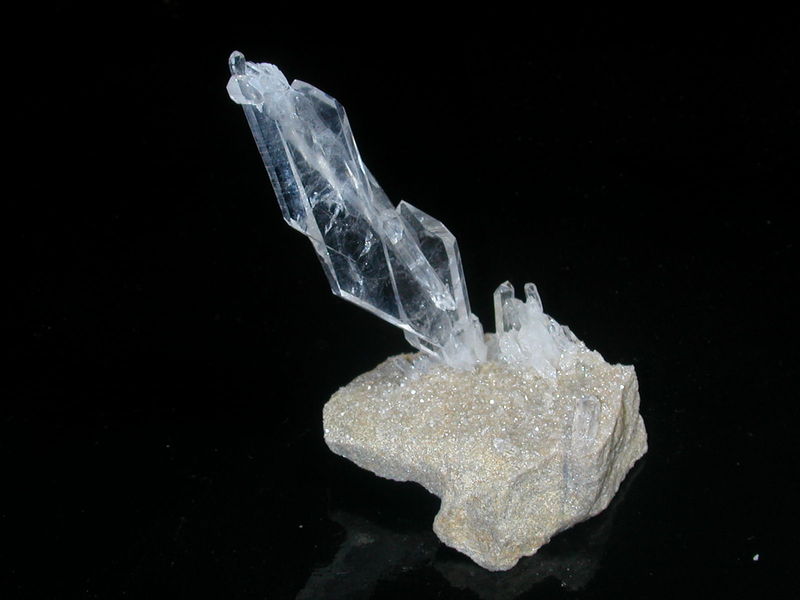
|
_________________
John S. White
aka Rondinaire |
|
| Back to top |
|
 |
alfredo
Site Admin

Joined: 30 Jan 2008
Posts: 1011



|
 Posted: Dec 20, 2016 07:40 Post subject: Re: Faden Quartz Crystals - (26) Posted: Dec 20, 2016 07:40 Post subject: Re: Faden Quartz Crystals - (26) |
|
|
A photo taken by Jimmy MacNeil of one of the many faden quartzes he and Hisami mined from the Stand-on-your-Head claim in Arkansas. It shows evidence of movement of the widening fissure during growth, or rather one faden is younger than the other and direction of fissure widening changed? Or perhaps one of the crystals just broke of the wall and rotated as it fell into a new position - probably more likely.
John's "terminated" faden I'd interpret as one where the "thread" broke because the fissure was widening faster than the quartz was growing, which must have been a common circumstance.
| Mineral: | Quartz (variety faden) |
| Locality: | | Stand-on-Your-Head No. 1 Mine, Bland, Saline County, Arkansas, USA |  |
|
| Dimensions: | 4 cm |
| Description: |
|
| Viewed: |
62315 Time(s) |
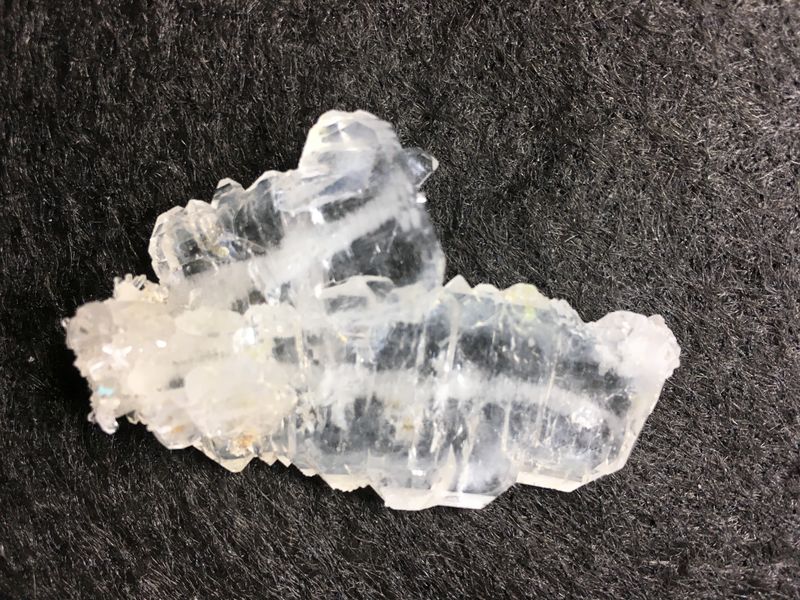
|
|
|
| Back to top |
|
 |
marco campos-venuti

Joined: 09 Apr 2014
Posts: 227
Location: Sevilla



|
 Posted: Dec 20, 2016 08:15 Post subject: Re: Faden Quartz Crystals - (26) Posted: Dec 20, 2016 08:15 Post subject: Re: Faden Quartz Crystals - (26) |
|
|
Hi Pete, thanks for your deep reply. But despite your strong preparation, I continue to have more questions than answers. Waiting for the paper of Jesús Fraile and Miguel Calvo, I retouched the diagram and I want to pose more questions.
I add to the diagram the case of single crystal faden with angle C-T near to 0 (C axis-Thread). This is rarely collected because in appearance it is not a faden.
Here some more question:
1-Why the movement of the fracture cause the rupture of the quartz crystal instead the rupture at the contact with the host rock? This is the weak point and anyone that have dug for quartz knows it.
2-Why the remains of the repeated fractures have all the same size and they are all parallel each other? You can imagine that a crystal broke twice in the same point? And repeat it hundred of times? And why parallel? Is like to win the lottery hundred of time with the same number?
3-I don't understand why the fresh fracture would be more suitable for overgrowth? Is common the case in which a fracture in a quartz crystal is overgrown on both side, but is not sealed and still remain an open fracture with two recrystallized quartz crystals.
4-Why we have no evidences of the inner fracture of the crystal, the last one? Almost one long fracture crossing the whole crystal, never!
5-Why the fractures of the crystal never reaches the surface of the crystal and they are confined to the core of the crystal?
6-Despite the angle between the "thread" and the C axis can vary from 90 to 0, the "thread" lies always in the middle. Why?
7-All alpine fissures move, but faden are still rare, why? Numerous crystals are found touching with their top point at the wallrock without being fades.
8-Fibrous quartz filling rock fractures is quite common and is formed in opening fractures by the same fracture-migration-process that is supposed to be responsible for the faden formation. Why in some case we have fibrous quartz and in other faden crystals?
9-There are too many curves in the faden "thread". Plate tectonic is quite straight phenomenon and its curves have an other scale. So I expect the threads to be straight.
10-Can we have some relation between fadens and gwindels?
11-Pete think there are almost two phenomena responsible for the formation of faden (its point 2)? A convergent evolution?
12-You said that mono-crystals are the result of overgrow? And multi-crystal are associated with high nucleation of the overgrowth? If you broke a single crystal during the fracture-migration-process you continue to have a single crystal. So over what they overgrow?
13-Why many fadens are well terminated?
Multicrystals are much more common than single crystals fadens. And between the single crystals, the more common are the intermediate angles, while near 0 and near 90 are quite more rare. This is what I will expect from a random relation. I never found a real 0 or a real 90.
My impression is that the fracture-migration-process theory, despite theoretically possible, it is not likely to be responsible of the genesis of faden crystals. I expect a quite different result from that process. The event of broke and seal a crystal is a rare phenomenon and I guess it would very difficult to repeat it more than few times in a single crystal and never in a so constant and repetitive way. Fractures must to run randomly.
In my opinion the process must to be in relation to the overgrow of quartz along a preexisting thread. I have no idea of what kind of thread, but a chalcedony thread often covered by chlorite can be a good candidate. In an agate geode this is a common situation with chalcedony thread crossing the cavity and pending from the roof. The presence of chlorite family minerals is also common giving as a result moss agates. Similar situations are often found without the agate filling of the cavity, for example in the basaltic geodes from India where chalcedony is often found at the core of quartz stalactites or other zeolites. The bubbles in the thread can be the result of loss of water from the chalcedony.
The overgrow of quartz over a chalcedony thread would explain in my opinion much better the different structures found in faden crystals. This will also be correct in case of faden made by epidote, adularia and also gypsum. Doesn't matter which mineral overgrow the thread, it will always make a faden crystal.
In my opinion:
A FADEN IS FORMED BY OVERGROW OF QUARTZ OR OTHER MINERALS OVER A CHALCEDONY THREAD
| Mineral: | Faden quartz crystal diagram |
| Description: |
|
| Viewed: |
62316 Time(s) |
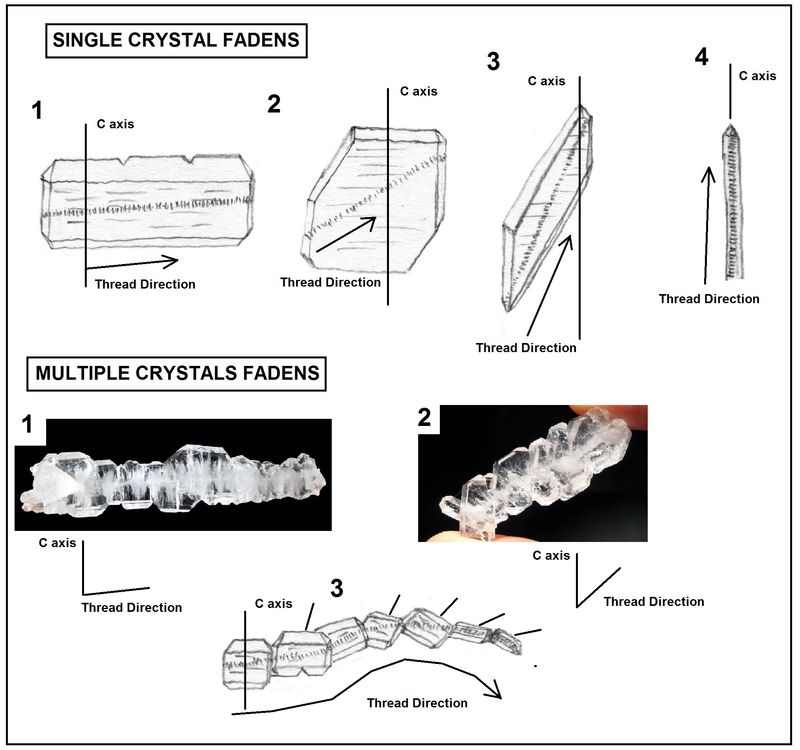
|
|
|
| Back to top |
|
 |
Pete Richards
Site Admin

Joined: 29 Dec 2008
Posts: 843
Location: Northeast Ohio



|
 Posted: Dec 20, 2016 10:42 Post subject: Re: Faden Quartz Crystals - (26) Posted: Dec 20, 2016 10:42 Post subject: Re: Faden Quartz Crystals - (26) |
|
|
Hi Marco,
You raise many questions, and I cannot answer all of them, nor do I want to discuss each point over many "pages". In spite of that, I appreciate the extent to which you have obviously thought about the phenomenon of faden quartz.
Many of your questions are "why" questions. I suggest that we are involved in trying to understand and describe in detail a mineralogical phenomenon. Whether or not we can say WHY it happened in every detail, it still happened, and our job is to try to understand it as completely as possible.
My reading of the evidence I have seen is that faden quartz development is basically a two-step process - formation of the faden followed by its overgrowth. Faden must span the vein in which they occur, otherwise they stop growing (and this happens frequently, apparently) but still remain available to be a seed for quartz overgrowth. We rarely see faden crystals in place, so specimens like John's are really valuable evidence. Although faden crystals are rare overall, they are common and even typical in certain very specific places, typically in alpine vein environments. But only in specific alpine vein localities where the delicate balance of conditions was realized to allow them to form.
I think the chalcedony hypothesis is likely to fail for several reasons. One is geographical - chalcedony is wide-spread and not confined to alpine environments, so faden quartz should be also. The other is that chalcedony is polycrystalline, so there is no reason for the overgrowing quartz to be all in one (or occasionally two or maybe three) directions,
Ultimately, the way to evaluate these two alternative explanations is to look in detail at the resulting crystals, by means of thin sections examined microscopically (which was done in my work). Chalcedony has a very different appearance in thin sections examined in polarized light than does a (single crystal) faden. Not everyone has the equipment to do so, but one could have a first look with a normal binocular microscope and two sheets of polaroid plastic, one above and one below a faden crystal, and with illumination from below. I encourage you to find the opportunity to do so, and to share your findings.
I attach two images of faden quartz that I think are quite informative.
| Mineral: | Quartz |
| Locality: | | Windsor (Richmond), Le Val-Saint-François RCM, Estrie, Québec, Canada |  |
|
| Dimensions: | unknown, about 1 cm or less |
| Description: |
| A single crystal with faden, viewed under cross-polarized light. The uniform color between the faden region and the surrounding crystal shows that they are in the same crystallographic orientation. The color changes from one end to the other because the thickness of the section changes. |
|
| Viewed: |
62334 Time(s) |
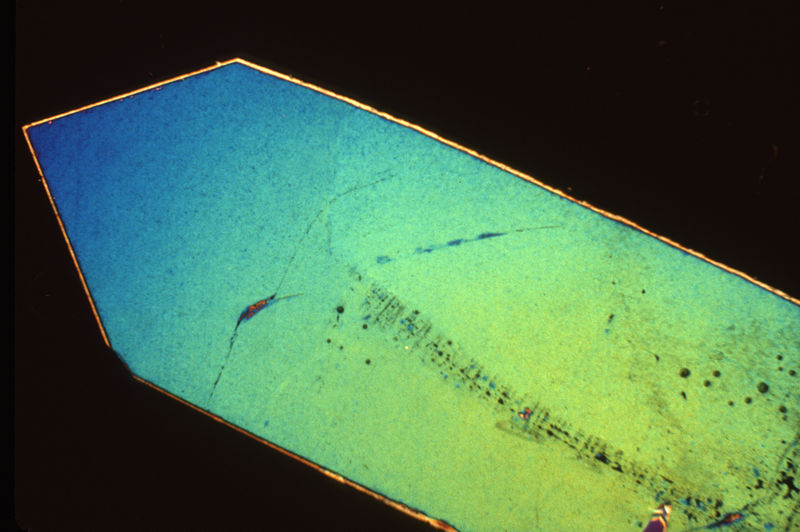
|
| Mineral: | Quartz |
| Locality: | | Piz Sardona, Glarus Alps, Unteriberg, Schwyz, Switzerland |  |
|
| Dimensions: | unknown |
| Description: |
| Walter Böniger collection (in 1990). Several faden crystals spanning their vein. Different faden orientations lead to different crystal shapes. Not all crystal are faden crystals, but those that are have parallel faden, or nearly so. |
|
| Viewed: |
62275 Time(s) |
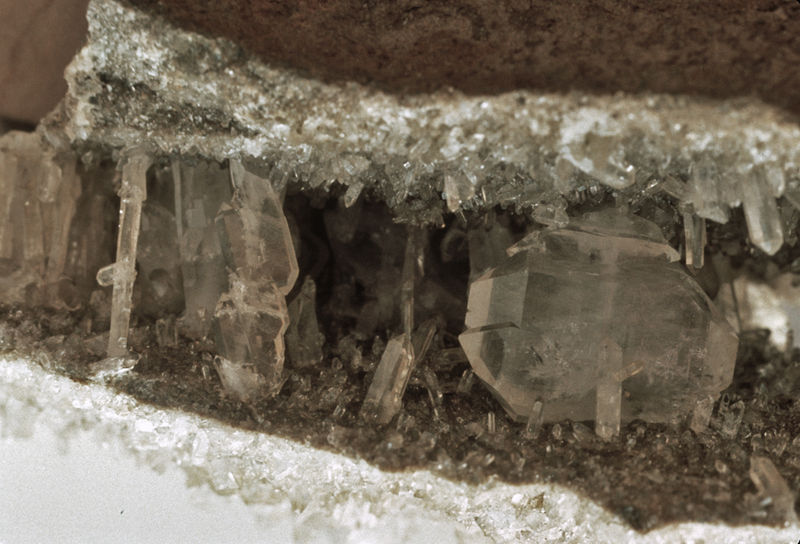
|
_________________
Collecting and studying crystals with interesting habits, twinning, and epitaxy |
|
| Back to top |
|
 |
Pete Richards
Site Admin

Joined: 29 Dec 2008
Posts: 843
Location: Northeast Ohio



|
 Posted: Dec 20, 2016 11:48 Post subject: Re: Faden Quartz Crystals - (26) Posted: Dec 20, 2016 11:48 Post subject: Re: Faden Quartz Crystals - (26) |
|
|
| marco campos-venuti wrote: | Hi Pete, thanks for your deep reply.
(cut)
10-Can we have some relation between fadens and gwindels?
(cut)
|
This is a rather different question and deserves a separate answer. Mine is that there is no relationship between fadens and gwindels, except that both are unusual forms of quartz crystals.
- Gwindels lack the faden that defines faden crystals.
- Gwindels and faden are rarely, if ever, found in the same vein or pocket together
- Faden crystals are randomly oriented crystallographically but gwindels have a specific orientation - c-axis parallel to the substrate, and one a-axis in contact with the substrate and elongated to produce the gwindel morphology
- Faden crystals rarely twist, but gwindels are systematically and continuously twisted and the amount of the twist is related to the dimensions of the crystal.
_________________
Collecting and studying crystals with interesting habits, twinning, and epitaxy |
|
| Back to top |
|
 |
Pete Richards
Site Admin

Joined: 29 Dec 2008
Posts: 843
Location: Northeast Ohio



|
 Posted: Dec 20, 2016 17:39 Post subject: Re: Faden Quartz Crystals - (26) Posted: Dec 20, 2016 17:39 Post subject: Re: Faden Quartz Crystals - (26) |
|
|
A final comment: here are some images of a "baby" faden vein from Quebec. The vein is only 5 mm tall, so no large faden crystals can be expected! But this illustrates the completion of some faden and their overgrowths from one side of the vein to the other, and the failure of others to keep up with the process. Food for thought.
| Mineral: | Quartz |
| Locality: | | Autoroute 55 roadcuts, Windsor (Richmond), Le Val-Saint-François RCM, Estrie, Québec, Canada |  |
|
| Dimensions: | Vein is 4 mm tall |
| Description: |
| Small vein with faden quartz crystals some of which span the vein and some of which do not. |
|
| Viewed: |
62188 Time(s) |
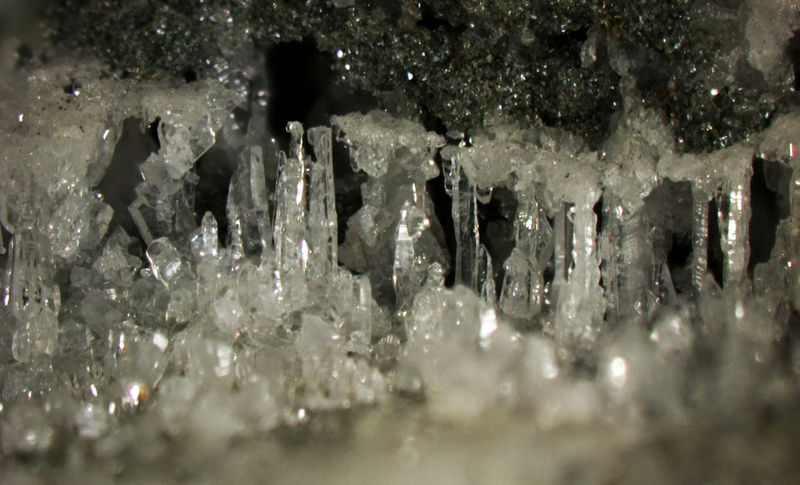
|
| Mineral: | Quartz |
| Locality: | | Autoroute 55 roadcuts, Windsor (Richmond), Le Val-Saint-François RCM, Estrie, Québec, Canada |  |
|
| Description: |
| One faden crystal that spans the vein |
|
| Viewed: |
62154 Time(s) |
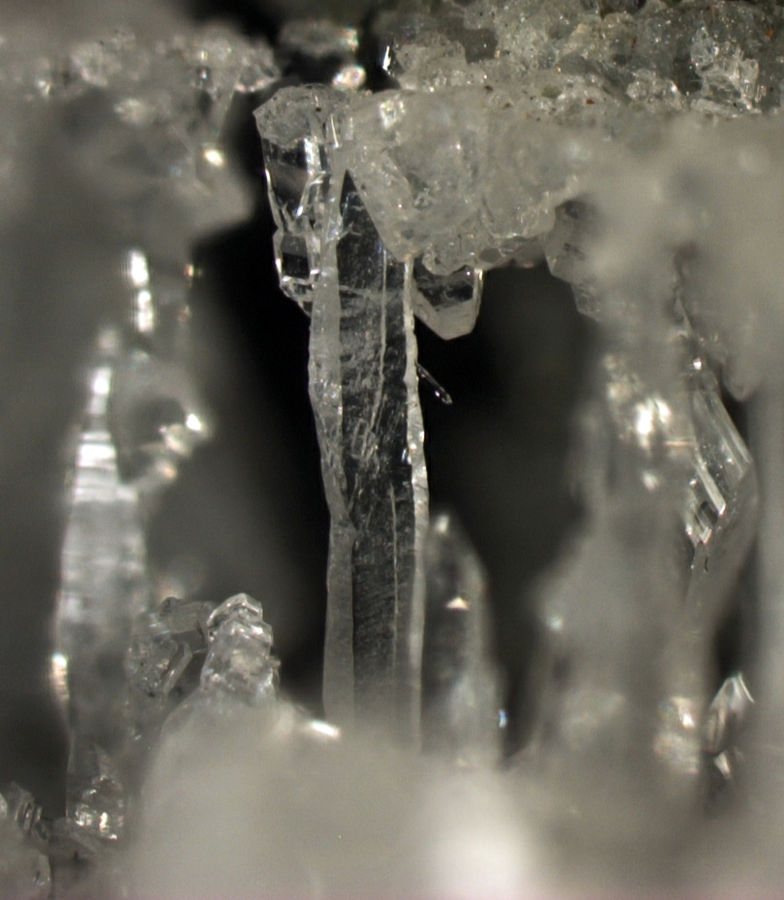
|
| Mineral: | Quartz |
| Locality: | | Autoroute 55 roadcuts, Windsor (Richmond), Le Val-Saint-François RCM, Estrie, Québec, Canada |  |
|
| Description: |
| Two more faden crystals from the same vein with quite different morphologies |
|
| Viewed: |
62113 Time(s) |
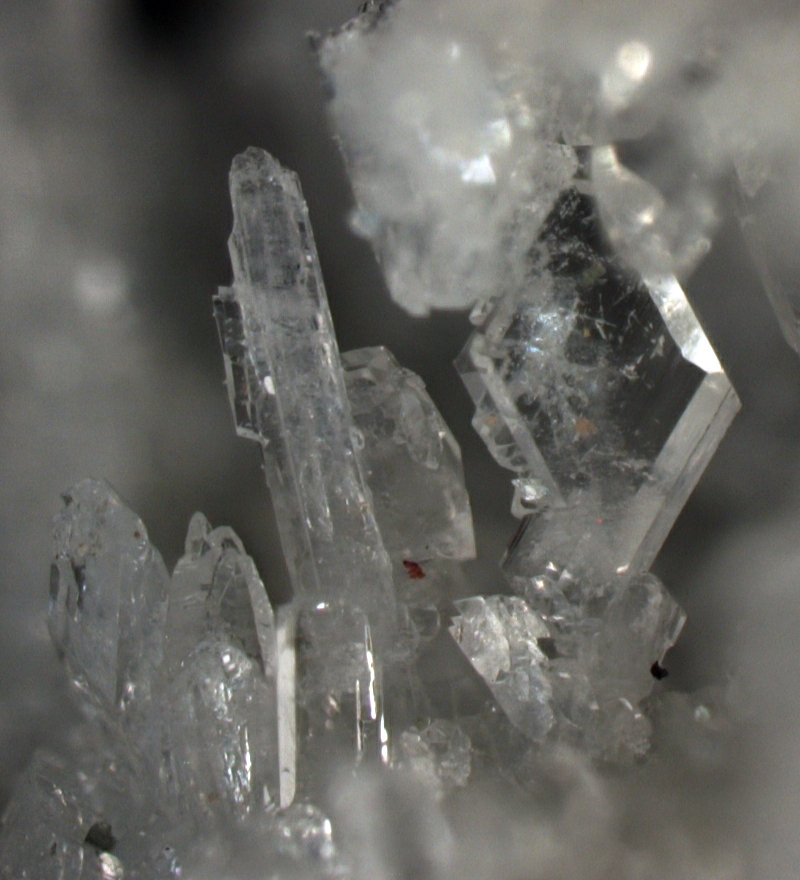
|
_________________
Collecting and studying crystals with interesting habits, twinning, and epitaxy |
|
| Back to top |
|
 |
marco campos-venuti

Joined: 09 Apr 2014
Posts: 227
Location: Sevilla



|
 Posted: Dec 21, 2016 07:31 Post subject: Re: Faden Quartz Crystals - (26) Posted: Dec 21, 2016 07:31 Post subject: Re: Faden Quartz Crystals - (26) |
|
|
WOW! Those are nice specimens. More geologically than aesthetic, but for me are real treasures!! I'm happy Pete you are so involved in the theme. I just want to clarify my appreciation to your experience and nothing personal in the discussion. Talk is the best way to understand. I don't have an answer and I have nothing against your theory, just that it does not convince me. Not yet.
My way to look for the truth is to pose all the reasons "why" I can and then try to find the those responsible for the crime. The genetic hypothesis must answer How it can be formed and Why is not formed in other way. We can say they can form by the fracture-migration-process or by the landing of extraterrestrial collectors, but only the truth can answer to all the "why?".
I tried to draw a step by step diagram of the fracture-migration-process and it is not running.
1- In step 2 I don't believe the quartz will break in this way, in the middle and parallel to the fracture.
2- In step 3 I don't believe the sealed fracture leave remains only in a small portion in the core of the crystal.
3- I don't believe the steps 1-2-3 can be repeated hundreds of times without variation, fractures parallel each other and with bubble line with the same extension.
From your superdidactic specimens I just can see that many crystals are touching both sides of the fracture, but we are far from demonstrating that they are formed during wallrock movement. The same I can expect if they were overgrown over a preexisting thread making a bridge in the fissure.
Why the fadens are not parallel to each other as happens in fibrous quartz vein filling or for example in tiger eye?
From the polarized section I can see that the the thread is clearly curved and this is not as predicted by the fracture-migration-process theory.
The idea of chalcedony is just a working hypothesis, can be anything. Just chalcedony often produces filaments and is composed of quartz. But I'm still convinced that faden crystals grows over something.
| Mineral: | fracture-migration-process diagram |
| Description: |
|
| Viewed: |
62066 Time(s) |
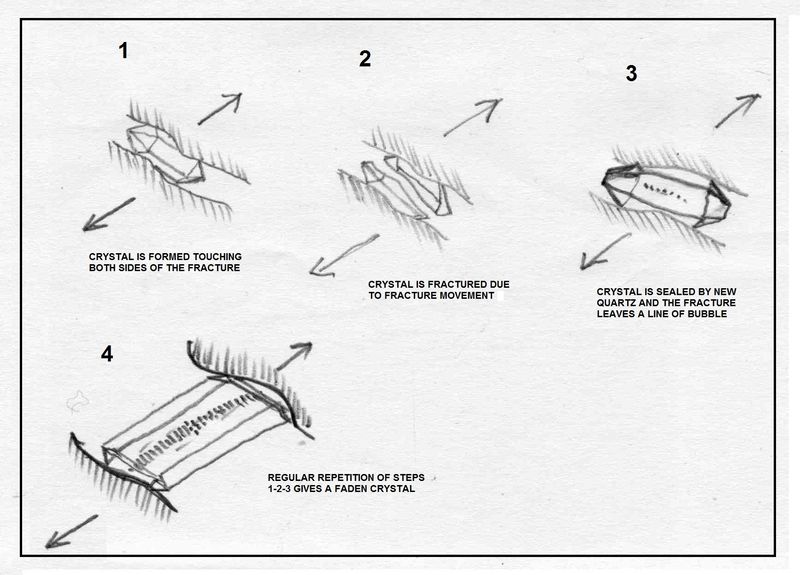
|
|
|
| Back to top |
|
 |
Pete Richards
Site Admin

Joined: 29 Dec 2008
Posts: 843
Location: Northeast Ohio



|
 Posted: Dec 21, 2016 14:25 Post subject: Re: Faden Quartz Crystals - (26) Posted: Dec 21, 2016 14:25 Post subject: Re: Faden Quartz Crystals - (26) |
|
|
| marco campos-venuti wrote: | (snip).
Talk is the best way to understand.
(snip)
I tried to draw a step by step diagram of the fracture-migration-process and it is not running.
1- In step 2 I don't believe the quartz will break in this way, in the middle and parallel to the fracture.
2- In step 3 I don't believe the sealed fracture leave remains only in a small portion in the core of the crystal.
3- I don't believe the steps 1-2-3 can be repeated hundreds of times without variation, fractures parallel each other and with bubble line with the same extension.
(snip)
Why the fadens are not parallel to each other as happens in fibrous quartz vein filling or for example in tiger eye?
From the polarized section I can see that the the thread is clearly curved and this is not as predicted by the fracture-migration-process theory.
|
Talk is a good way to understand, pictures are an excellent help! Yours communicate your ideas quite well! Your concept differs from mine in ways that may help to explain why we disagree. I do not visualize a quartz crystal spanning the vein as you have drawn, and then breaking and healing with just the middle having bubbles. I agree that such a model has many issues.
I imagine that the starting point for the faden - the thread - is a grain of quartz that is part of the matrix, and that is broken when the rock cracks at the beginning of opening into a vein. It may seem unlikely that such a grain would break instead of coming free from one side or the other, and indeed detachment may happen some times rather than fracture. In that case there is no faden. But if the grain does break, it is likely to break in a direction more or less perpendicular to the stress being put on it, as shown by your arrows. The crack then heals, leaving some bubbles behind. Then the grain breaks again, not necessarily in the same place, but probably with a similar orientation because the direction of the stress is the same. This goes on until the faden - the thread - is developed. There is as yet no crystal surrounding it. Why does no quartz grow on the side of the faden but only in the crack. I cannot say, but I can suggest that the outside of the thread is a less clean surface than the new crack, and so less conducive for new crystal growth. At this stage we have a thread with a series of healed cracks and with bubble trails that go basically all the way across. Then the overgrowth of quartz starts, and the full faden crystal develops. Again I cannot say why this happens, but without it one does not get a full faden crystal. There are abundant examples of minerals that grew, stopped growing, and started again, but only in a few spots because the rest of the surface was somehow an inappropriate substrate.
This is why the crack is only in the middle of the final crystal, and why the crystal is more or less uniformly developed around it. The crystal's form is a result of growth starting along a line rather than at a spot, interacting with the natural shape of the crystal.
You mention fibrous quartz vein fillings. I have never had a good specimen of this, but I would say (and this is not my idea) that these are (or can be) a dense aggregate of fadens - threads - formed by the same mechanism, but with the threads all packed in together, as might happen with a vein in sandstone or quartzite, and no room remaining for later overgrowths to develop any distinctive morphology. If so, they should also have the distinctive bubble "ladders" in each fiber.
You ask why the faden are not parallel. Generally speaking, they are parallel most of the time. On some other "intact" specimens I have, they stick up essentially perpendicular to the surface and parallel to each other like the bristles of a brush, but here and there one has broken off and tipped over, now cemented at an angle or lying on the matrix. I suspect that in some veins most of the faden develop into complete faden crystals after being detached and falling to the bottom of the vein, in which case they would be like straws, certainly not parallel to each other but perhaps tending to all be parallel to a common plane. And the resulting faden crystals would probably intergrow and be very difficult to recognize!
In the polarized light image, you are quite right that the faden is curved. Interestingly, the enclosing crystal is not. In fact, the uniform color shows that the faden's crystal lattice is NOT curved, even though the faden is. How can this happen. It seems improbable, and indeed is not typical, but it would seem to require that the faden development involved some shearing movement as well as a straight separation. If the extra movement were rotational, the crystal structure of the faden would have been rotated as well. Possibly the amount of curve in the structure would be too small to be detected optically - I am not sure.
Faden crystals form a highly coherent group characterized by the faden, which macroscopically looks like an opaque or translucent thread and microscopically contains the distinctive train of bubble inclusions, as I suggested like the steps of a ladder. This is so completely so that it becomes a tautology - that's what defines a faden crystal and if it lacks this feature (including the details of the structure) it's not a faden crystal. Fair or not, I think it is true. Certainly there are other examples of crystals with interior linear features, and in some cases there is even a clear crystallographic relationship between the interior linear feature and the distorted morphology of the overall crystal, but I would not be inclined to call them faden crystals because doing so implies all kinds of additional information that is true of "real" faden crystals but not of these "pseudo-faden" crystals.
But if we are speaking of what we generally mean when we talk about or show pictures of typical faden crystals, alternative theories of origin must account not only for the thread and its crystallographic relationship to the overgrowing mineral, but for the trains of bubbles (two-phase inclusions, in fact) as well.
A final comment that I take seriously, and offer respectfully: Mark Twain once said, essentially, "Geology is a wonderful science. One gets such a wealth of conjecture from so few facts!" I have often said that a good geologist can come up with 10 hypotheses to explain something that needs no explanation! And the corollary is that a good geologist can come up with a dozen reasons to doubt almost anything. Look at how long it took before continental drift stopped being nonsense! There's so much that we cannot know for sure!
_________________
Collecting and studying crystals with interesting habits, twinning, and epitaxy |
|
| Back to top |
|
 |
marco campos-venuti

Joined: 09 Apr 2014
Posts: 227
Location: Sevilla



|
 Posted: Dec 22, 2016 06:16 Post subject: Re: Faden Quartz Crystals - (26) Posted: Dec 22, 2016 06:16 Post subject: Re: Faden Quartz Crystals - (26) |
|
|
Ok, now I understand your point:
1-you form the thread by continue fractures of a small tiny elongated crystal (the faden)
2-you overgrow the faden by a deformed quartz crystal.
In this case why the thread have traces of the fractures? A tiny crystal could repair easy completely.
Why the overgrown crystal is always deformed? Deformation of the crystals means that they are formed in an unusual environment. But if the unusual situation responsible for the formation of the thread is ended at the moment of the overgrowth, there is no reason for the crystals to be always deformed, flat or distorted. In some case would be possible to have a normal quartz crystal with a faden thread inside, but this never happens.
Now I want to try to think outside the box. Leaving aside the quartz and think about the fracture movement.
A fracture is the result of a stress release. Rocks are elastic at a geological scale. They support some stress, but when the stress exceed a threshold, there is rupture and an earthquake. Strongest the earthquake, more important the fracture. Some earthquake are generated along few km long faults, other smaller just few cm long. But because of the elastic nature of the rocks, these fractures can not be indefinitely smaller. In other words, the elastic energy accumulated prevent the formation of very small fractures.
In the fracture-migration-faden model, there is the assumption that microfaults can be very very small, in the order of few fractures for mm. The single quartz crystal is not elastic, so it behaves as a fragile material and breaks at any minor movement. But this is not true for the wallrock containing the alpine fissure. A geologic mass of gneiss support an important quantity of stress and the release of this stress is responsible for the formation of the alpine fissures, but the growing of the fissure is made in a few steps or just in one single event, but is not a continuum.
Alpine Fissure-type veins are concentrated on folds in gneiss or granite and are a relatively surficial phenomenon. Deeper in the crust where rock behaviour is more ductile, the fissures are rapidly filled, forming pegmatites or quartz veins.
I suspect this is the end of the fracture-migration theory. R.I.P.
|
|
| Back to top |
|
 |
Jordi Fabre
Overall coordinator of the Forum

Joined: 07 Aug 2006
Posts: 5025
Location: Barcelona



|
 Posted: Dec 22, 2016 09:31 Post subject: Re: Faden Quartz Crystals - (26) Posted: Dec 22, 2016 09:31 Post subject: Re: Faden Quartz Crystals - (26) |
|
|
| Pierre Joubert wrote: | | What a fantastic thread Marco! |
Moved this fantastic thread to the Featured Columns of FMF section.
Please more! ;-)
|
|
| Back to top |
|
 |
|





